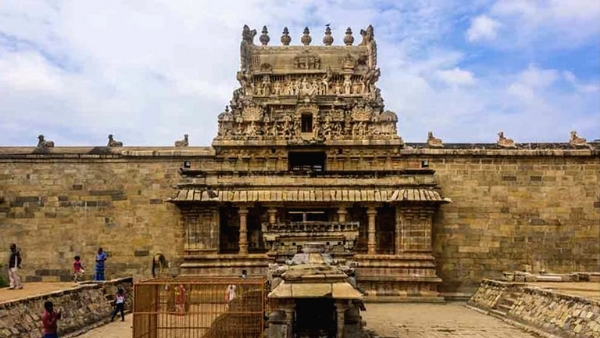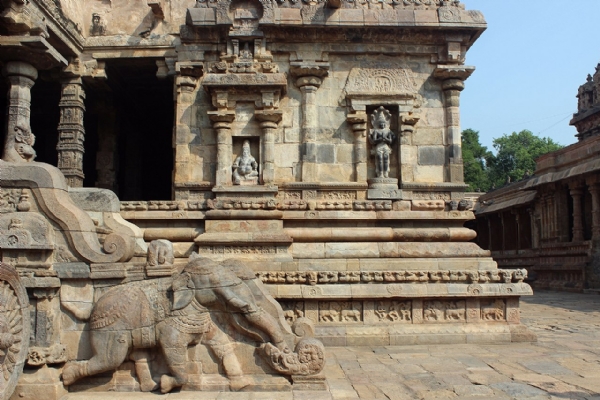Airavatesvara Temple, the intricate UNESCO heritage of Tamil Nadu
The temple attracts scores of pilgrims and devotees annually, prominently in the month of Magha for special poojas.
Total Views |
In the town of Darasuram, near Kumbakonam in Tamil Nadu, you will find the Airavatesvara temple – the ornate Hindu temple and a UNESCO world heritage site. It was built by the Chola King Rajaraja Chola II in the 12th century CE. Dedicated to Lord Shiva, the temple is part of the 18 medieval era Hindu temples in the Kumbakonam area. One among the 3 ancient temples that are called the Great Living Chola Temples, the Airavatesvara Temple is given the UNESCO heritage tag.

Architecture | Airavatesvara Temple was built during the Chola Empire between 1146 - 1172 CE by the Chola King Rajaraja II. Ayirattali was the secondary capital of the Cholas and Darasuram was part of the city complex. The king was a patron of Tamilian art and architecture and built many new temples and monuments during his reign. This temple was much bigger in size back in olden times, as compared to what it is today.

The exquisite carvings & sculptures that detail the entire temple structure are so magnificent that it leaves you speechless with its spellbinding charm and intricacies.


Built in the chariot structure and built-in stone, the temple has smaller shrines dedicated to many Vedic and Puranic deities like Indra, Agni, Varuna, Vayu, Brahma, Surya, Vishnu, and many more.
Lord Shiva’s spouse has a smaller shrine towards the northern side of the temple premises called Periya Nayaki Amman. The main shrine still stands tall here. The temple attracts scores of pilgrims and devotees annually, prominently in the month of Magha for special poojas.
History | The Airavatesvara temple was built during the Chola Empire between 1146 - 1172 CE by the Chola King Rajaraja II. Ayirattali was actually the secondary capital of the Cholas and Darasuram was part of the city complex. He was actually a patron of Tamilian art and architecture. He built several new temples during his reign. This temple was much bigger in size back in the day, but is now much smaller after going through ruins.
Also Read | Kopeshwar Temple, the architectural wonder of Khidrapur
The inscriptions of the temple found now state that the temple had seven streets and seven courts just like the Srirangam Temple. All of the main architecture has been damaged and destroyed; only the court with the chief shrine stays. The reason for this destruction is still unclear. Maybe, the temples came under later Hindu kings who restored and repaired them.
Architecture | Airavatesvara Temple was built during the Chola Empire between 1146 - 1172 CE by the Chola King Rajaraja II. Ayirattali was the secondary capital of the Cholas and Darasuram was part of the city complex. The king was a patron of Tamilian art and architecture and built many new temples and monuments during his reign. This temple was much bigger in size back in olden times, as compared to what it is today.

The inscriptions of the temple found, state that the temple had 7 streets and 7 courts just like the Srirangam Temple. The main architecture has been damaged and destroyed; only the court with the chief shrine remains. The gopurams are also in ruins. However, the reason for this destruction is unclear. Supposedly, the temples came under later Hindu kings who restored and repaired them.
The exquisite carvings & sculptures that detail the entire temple structure are so magnificent that it leaves you speechless with its spellbinding charm and intricacies.
Also Read | Laxminarayan Temple, the 17th century painterly temple in Orchha
Another interesting feature that takes you in wonder at the temple is its Musical steps. The small ornately carved flight of seven steps leading to the ‘Balipeetham’, the sacrificial altar of the temple, is the Musical steps. The 7 steps of this staircase represent the 7 musical notes. The main significance of the steps is that when one walks / taps them, they produce all 7 ‘swaras’ or notes of music.

Legend | A legend that goes with the temple says that Lord Shiva was worshipped by Airavat - Lord Indra’s elephant. Airavat was cursed by sage Durvasa as he had disrespected the hermit. The curse went on to discolor the pearly white skin of the elephant. Airavat got his color back by taking a dip in the water tank of this Lord Shiva’s temple. That is how the temple got its name.


